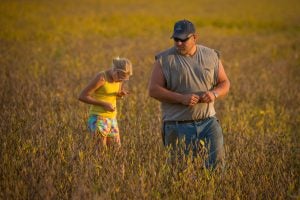You’ve heard the statistic time and time again: According to the U.S. Department of Agriculture, 90-some percent of all U.S. farms are family owned and operated. This is something we should be proud of, isn’t it? But if you’ve participated in discussions with fellow agriculturalists or passionate consumers, you may have heard a retort along the lines of, “The USDA intentionally ‘skews’ that number to make modern agribusiness seem nicer than it really is.”
What exactly is this criticism referring to? Is it a valid concern, or another ideology threatening to further divide the already shrinking ag community?
Today’s short-and-sweet family farm definition, according to the USDA, is “any farm organized as sole proprietorship, partnership, or family corporation.” This definition is intended to encompass the ever-changing dynamics among farming practices, technologies, and agribusiness structure, while preserving the integrity of individualized farm ownership and management. The USDA’s Economic Research Service explains these particulars very well. You can read the lengthy version here, but let’s call attention to this excerpt:
“The general concept of a family farm is one in which ownership and control of the farm business is held by a family of individuals related by blood, marriage, or adoption. Family ties can and often do extend across households and generations. Historically, it was not uncommon for the family farm to provide all of the labor for the farm and to own all of the land and capital of the farm. That is no longer true today, although the extent to which individual farms hire nonfamily labor, rent-in land or other capital, or contract for various farm services varies greatly across farms. In short, the organization of family farms changes over time.
“There is no hard-and-fast definition of a family farm, unlike the farm definition. In its program of analyzing the well-being of farm operator households using microdata, the ERS definition of family farms has changed over time. A preferred definition of a family farm would allow for organizational changes in the way in which operators structure their farm businesses as they respond to changes in technology, the marketplace, and policies, but still capture the general concept of a family farm in which a family unit maintains majority control and ownership.”
There are some organizations, groups, and individuals who reject this definition, arguing the criteria is much too broad. They bring up some familiar themes in their discussions — these tend to be hot-button topics like size, type of operation, technologies used, management style, and employment decisions.
Specifically, they will be quick to point out that among these “family operations” are very large acreages that use GMOs, have enough livestock to meet CAFO status, and/or hire multiple full-time employees. Conventional agriculture in general, some argue, is in and of itself at odds with the concept of true family farming. They say including these types of operations, regardless of who owns them, take away from the smaller niche-based operations that better fit the “real” family farm mold.
Opinions aside, most farm families, regardless of management style or marketing strategy, choose to formally incorporate, create LLCs, or arrange partnerships for their operations because of the business and legal advantages. Naturally when families grow, so will the business as necessary to support them. As a result, we often end up with multiple generations and their families becoming stakeholders in the same enterprise. More often than not, this growth and business success is taken with a critical eye rather than through the lens of an American dream.
Here’s just one example: An article challenged a USDA statistic that stated 89.7 percent of Iowa farms are family owned and operated. The author was quick to point out that in reality, only 6.36 percent of the state’s farms were “on small or medium acreages and run and owned by one family.” (Note that “small to medium acreage” in this particular article meant 260 to 999 acres.) So, in this instance, only the operations that fell within both of these specific parameters should be qualified as “family farms.”
Why is narrowing this definition problematic?
For one, consider the many generational farms that are composed of multiple families in multiple households. A specific example might be two brothers who are in a farm partnership inherited (or purchased) from their father. Each has a family of their own and now two of their adult sons are interested in formally joining the partnership, one of which is married and will be starting a family of his own. This particular farm will now be owned and operated by potentially four separate households sharing the same surname. And we haven’t even factored in the acreage, both leased and owned, of each party! Depending on who is tweaking the definition, this operation could easily not reach enough criteria to be a “family farm.”
The irony is we all want to support farms being passed down to subsequent generations. Yet as families and markets change, operations must inevitably do likewise to meet the evolving needs — but at a certain point the general public deems that is no longer OK, or at least frowned upon.
There’s some apparent need to draw a line, and once you cross it, you become a greedy faceless corporation. If that’s the case, how many acres should it be? Everyone has a different answer. Remember, there is but one animal difference between being full-blown CAFO status and not, at least in terms of legal and regulatory purposes. When a multi-generational farm grows to obtain their CAFO permits, purchases X many more acres, or adopts a new technology, do they suddenly cease to have the same morals and ethics as they did before?

A lot of consumers are quite vocal in criticizing established farms for growing “too large.” Yet whenever farmland is bought up by developer, there’s an eerie silence. For a long time now, the silence has implied it’s much less polarizing, and more acceptable, for tillable ground to simply be paved over.
Another criticism is that a lot of industries, such as hogs, poultry, and certain row crops are vertically integrated with contract growers. Aren’t these technically not “family owned and operated”? Everyone will have their opinion about the different production systems. How products are marketed is a volatile ever-changing thing. Direct-to-consumer marketing, co-ops and contracts all have their place in today’s food production system, because no single option works for every producer, everywhere.
Nevertheless, a lot of contract producers are still multi-generational farmers. With such a wide variety of labels, co-ops, and brands seeking producers, farm families can do business with companies that share their same values and practices. Look at all the respectable salt-of-the-earth imagery of family-oriented Amish farms, which have contracts with national labels for livestock and crops. If the marketing and production systems determine the “family farm” status, then we could easily strike off even these types of operations.
To put this into perspective, consider how the general definition of a “farm” is still inclusive of even the smallest, less-profitable operations. It means any place that produces and sells (or would have sold) agricultural products worth $1,000 in sales in a given year. It has nothing to do with actual profitability nor industrial competitiveness. In fact, a 2013 report from the ERS reported that 19 percent of all farm households had at least one family member working an off-farm job at any given time, and nearly 40 percent of farm operators reported this person was themselves and/or their spouse. Per the 2012 USDA census, of the 2.1 million farms in the U.S., 88 percent were classified as “small,” reporting less than $350,000 in gross cash farm income. That census also reported that 75 percent of all USDA-defined farms had sales of less than $50,000.
Despite holding such a large percentage of the farm population, people are quick to point out the farm policies — particularly federal aid, which usually comes in the forms of crop insurance, subsidies, and margin protection, among many other things — are designed with only the top few percent in mind. There may be some truth to this, however it is often overlooked how many Farm Service Agency and other USDA programs and grants are exclusively available to specialized family farms, including those of low revenue and small acreage.
With the rise of local food and specialty markets, efforts are being consciously made to make more assistance more accessible to more operations. In fact, the 2018 Farm Bill modified the Whole-Farm Revenue Protection, an insurance plan that “is tailored for any farm with up to $8.5 million in insured revenue, including farms with specialty or organic commodities (both crops and livestock), or those marketing to local, regional, farm-identity preserved, specialty, or direct markets.”
It has long been said there are as many different ways to farms as there are farmers. In that light, we can adjust the glass ceiling on the “family farm” terminology to exclude as many operations as we like. Ultimately, details such as agribusiness strategies, food technologies, operation type, and management style are very personal decisions. It has typically implied producers who veer toward the conventional end of these are inherently like the CEO fat cats and boards of directors who dominate our chain businesses and entertainment industries — a comparison that is not only unfair, but simply unrealistic.
Jaclyn Krymowski is a graduate of The Ohio State University with a major in animal industries and minor in agriculture communications. She is an enthusiastic agvocate, professional freelance writer, and blogs at the-herdbook.com.


